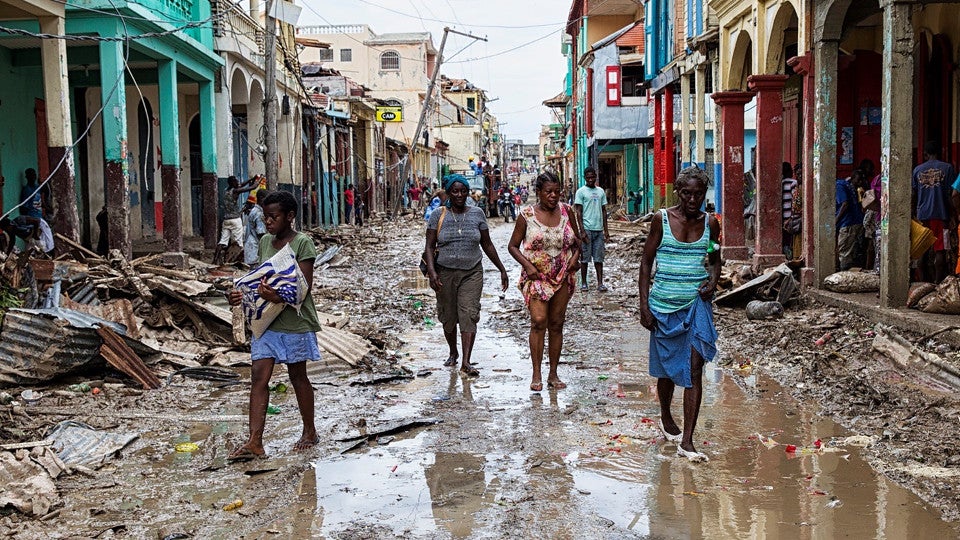In 2016, Category 4 Hurricane Matthew made landfall in the south of Haiti, causing destruction unseen in more than a decade during the hurricane season, with winds as high as 230 kilometers per hour and 600 millimeters of rain in less than 24 hours. The toll was very high, with a total of 546 victims, 128 missing, 439 injured, and 2.1 million people affected.
Following the disaster, the Government of Haiti (GoH) was confronted with the challenge of determining the overall economic impact in order to gauge the magnitude of the event, identify priority sectors for reconstruction, understand different geographic impacts, and comprehend relative public versus private damages. Therefore, the Government performed a rapid damage and loss assessment with technical support from the World Bank and the Inter-American Development Bank (IDB) to help put in place a relief, recovery, reconstruction, and development plan. In a context marked by extreme urgency, it was imperative to swiftly estimate the damages in order to assign the appropriate financial resources for the recovery efforts.
There was an absence of information on the actual impacts of the hurricane, and reaching the affected areas was complicated by road conditions, which were in a poor state after the passage of the hurricane. In addition, roads were vacated as much as possible to facilitate the job of emergency services. This raised a challenge – how could the damages and losses be properly assessed?
This was done through the GRADE assessment, an innovative methodology developed by the World Bank with the support of the Global Facility for Disaster Reduction and Recovery (GFDRR). Using disaster risk modeling techniques, in combination with historical damage data, census and socioeconomic survey data, satellite imagery, drone footage, and other media, the GRADE assessment rapidly quantifies damages, providing support to governments in the estimation of losses.
Figure 1 - Tracking Hurricane Matthew – Source: HaitiData.org
To implement the GRADE assessment, remote sensing is critical. In this case, the National Center for Geospatial Information in Haiti (Centre National de l'Information Géo-Spatiale – CNIGS) provided geographic information system (GIS) and spatial data support, and a first attempt was carried out through satellite imagery. Unfortunately, it was prevented by the state of Haiti’s telecommunications infrastructure (i.e., low internet bandwidth) after the disaster, the presence of clouds obstructing the view, and the relatively low resolution of the available imageries.
Upon realizing that it was not going to be possible to work with satellite data, but that it was still necessary to analyze the situation in the affected areas, a second attempt at remote sensing was done using Unmanned Aerial Vehicles (UAVs), more commonly known as drones, which successfully mapped key communes in areas where the force of Matthew had been especially disruptive, such as the Grand’Anse and the Sud departments.
Figure 2 - Target areas for drone flights - Source: Giovanni Michele Toglia
The maneuverability and ease of use of drones allowed for a quick collection of high-resolution images, and in four days, teams from the World Bank and the IDB covered a total of seven villages and two cities, and gained a much clearer view of the situation on the ground. The devastating contrast between Haiti pre- and post-Matthew was condensed into a short video, below.
Figure 3 - Les Anglais (Sud Department) - Source: IDB
Figure 4 – High resolution drone image of the Immaculate Conception Church in Les Anglais (Sud Department) - Source: IDB
One tool the World Bank team used to compare pre and post disaster conditions, were orthophotos, which are aerial photos or satellite images that are geometrically corrected so the scale is uniform. Following the remote sensing assessment, orthophotos taken a few months prior to Matthew were used to measure the damage inflicted by the hurricane to schools. By comparing the images obtained through the drones with images of the same spots prior to Matthew, the team was able to determine which schools, and therefore which municipalities, had suffered the worst damages.
The assessment was completed in merely fifteen days and it was a first, crucial step towards the resolution of the emergency situation, and ultimately towards reestablishing livelihoods in Haiti. The activity also encouraged the use of spatial data and remote sensing in other projects in Haiti, including the IDA-financed Disaster Risk Management and Reconstruction Project (PRGRD) and Strengthening Disaster Risk Management and Climate Resilience Project (PGRAC), where spatial data was used to identify areas in which emergency shelters were most needed, based on population, hazard exposure, accessibility, and location relative to shelters geographic position. Under the PGRAC Project, the CNIGS is currently setting up the first official drone lab of the GoH, and is boosting the use of spatial data through the promotion of the open-data GIS platform HaitiData.org.
As Haiti enters the 2021 hurricane season, while experiencing continued instability and with mobility restrictions due to the COVID-19 pandemic, it is crucial the country continues to invest in and apply new technologies like spatial data and remote sensing for future post-disaster assessment, project implementation, and supervision, to make sure critical work can be carried out even in unfavorable circumstances.
The activities described in this blog were cofinanced with the support of the European Union (EU) and the Global Facility for Disaster Reduction and Recovery (GFDRR).









Join the Conversation